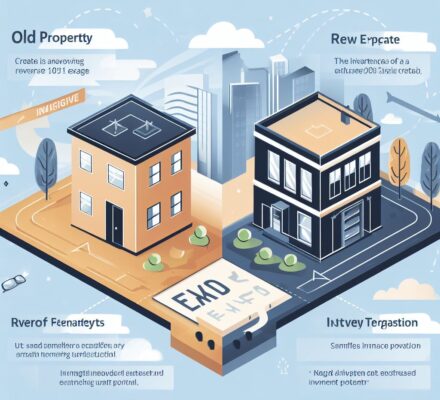Are you looking to sell your property and find the perfect replacement?
Imagine this: you’ve sold your property and now have a great opportunity to invest in a new one. But where do you start?
In this in-depth guide, we’ll walk you through the 1031 exchange process and help you identify potential replacement properties.
We’ll guide you in evaluating their financial viability, considering location and market trends, and ultimately making the final selection to close the deal.
Let’s dive in and find your perfect replacement property!
Key Takeaways
- The 1031 exchange process allows for tax-deferment when selling and reinvesting in properties, as long as the properties are held for investment or business purposes.
- When identifying potential replacement properties, it is important to consider factors such as location’s economic stability, growth potential, and proximity to amenities. Additionally, analyzing potential cash flow and return on investment for each property, researching local market trends and demographics, and conducting a thorough financial analysis are crucial.
- Evaluating the financial viability of options involves examining potential cash flow and calculating net operating income (NOI), analyzing potential appreciation, evaluating financing options and long-term affordability, and assessing overall risk through due diligence.
- Considering location and market trends is essential, and involves assessing the location’s desirability, studying current market trends, supply and demand, rental rates, and vacancy rates, researching planned or ongoing developments for potential future growth, and investing in high-demand areas for steady income or potential appreciation.
Understanding the 1031 Exchange Process
To understand the 1031 exchange process, you need to familiarize yourself with its key components and requirements. This tax-deferment strategy allows you to sell your investment property and reinvest the proceeds into another property, all while deferring capital gains taxes.
The first key component is the requirement that both the relinquished property (the property you’re selling) and the replacement property (the property you’re buying) must be held for investment or business purposes. Personal-use properties, such as your primary residence or vacation home, don’t qualify.
Additionally, there are strict time limits involved. Once you sell your relinquished property, you have 45 days to identify potential replacement properties. This identification must be done in writing and submitted to a qualified intermediary or a person involved in the exchange.
After identifying the potential replacement properties, you have a total of 180 days to complete the exchange by acquiring one or more of the identified properties. It’s crucial to note that failure to meet these time limits will result in disqualification of the exchange and the realization of capital gains taxes.
Understanding these key components and requirements is essential as you move forward to identify potential replacement properties.
Identifying Potential Replacement Properties
Start by identifying your potential replacement properties. This step is crucial in the 1031 exchange process as it determines the options available to you for reinvesting your proceeds.
Here are three key factors to consider when identifying potential replacement properties:
- Location: Location plays a vital role in the success of any real estate investment. Consider the location’s economic stability, growth potential, and proximity to amenities such as schools, shopping centers, and transportation. Research local market trends and demographics to ensure you choose a location with strong investment potential.
- Property Type: Determine the type of property that aligns with your investment goals. Are you looking for residential properties, commercial properties, or a mix of both? Consider the demand for the property type in the chosen location and its potential for rental income or future appreciation.
- Cash Flow and Return on Investment: Analyze the potential cash flow and return on investment for each replacement property. Consider factors such as rental income, operating expenses, vacancy rates, and potential tax benefits. Conduct a thorough financial analysis to determine if the property will generate the desired returns.
Evaluating the Financial Viability of Options
Now, let’s evaluate the financial viability of your potential replacement properties to ensure they align with your investment objectives and maximize the benefits of a 1031 exchange. Evaluating the financial viability of your options is crucial in making an informed decision.
Start by examining the potential cash flow of each property. Consider the rental income and operating expenses, such as property taxes, insurance, and maintenance costs. Calculate the net operating income (NOI) to determine the profitability of each property.
Next, analyze the potential appreciation of the properties. Review historical price trends in the area and consult with local real estate experts to gauge the potential for future growth. Keep in mind that the goal of a 1031 exchange is to defer capital gains tax, so it’s important to select properties with strong appreciation potential.
Additionally, consider the financing options available for each property. Evaluate the interest rates and terms offered by lenders to determine the long-term affordability of the investment. Be sure to factor in any potential changes in interest rates that could affect your cash flow.
Lastly, assess the overall risk associated with each property. Consider factors such as location, market demand, and tenant quality. Conduct thorough due diligence, including property inspections and financial analysis, to mitigate any potential risks.
Considering Location and Market Trends
Evaluate the location and market trends of your potential replacement properties to ensure they align with your investment objectives and maximize the benefits of a 1031 exchange. Considering location and market trends is crucial in making an informed decision. Here are three key factors to consider:
- Location: Assess the location of the potential replacement property. Is it in a desirable area? Consider factors such as proximity to amenities, schools, transportation, and employment centers. A property located in a high-demand area has a higher chance of attracting tenants or buyers, ensuring a steady stream of income or potential appreciation.
- Market Trends: Study the current market trends in the area. Look at factors such as supply and demand, rental rates, and vacancy rates. A market with high demand and low supply indicates potential for rent growth and property appreciation. Conversely, a market with excess supply and low demand may lead to stagnant rental income and limited appreciation.
- Future Development: Research any planned or ongoing developments in the area. New infrastructure projects, commercial centers, or residential developments can significantly impact property values and rental demand. Investing in a location with potential future growth can lead to long-term benefits.
Making the Final Selection and Closing the Deal
To make the final selection and close the deal for your replacement property in a 1031 exchange, consider these essential factors.
First and foremost, thoroughly evaluate the property’s financials. Look at the potential rental income, operating expenses, and projected return on investment. It’s crucial to ensure that the property aligns with your financial goals and provides a stable income stream.
Next, conduct a thorough inspection of the property. Hire a professional inspector to identify any structural issues, potential maintenance needs, or code violations. This step is crucial to avoid any unexpected expenses down the line.
Furthermore, consider the location of the property. Is it in a desirable area with potential for growth? Research local market trends, job opportunities, and the overall economic outlook to assess the property’s long-term appreciation potential.
Don’t forget to review the lease agreements of existing tenants, if applicable. Analyze the terms, expiration dates, and rental rates to determine the stability of the property’s income stream.
Lastly, work with a qualified 1031 exchange intermediary to ensure a smooth transaction. They’ll guide you through the necessary paperwork, deadlines, and tax regulations to ensure compliance with the IRS rules.
Frequently Asked Questions
How Long Do I Have to Identify Potential Replacement Properties in a 1031 Exchange?
You have 45 days to identify potential replacement properties in a 1031 exchange. It’s important to carefully consider your options within this timeframe to ensure you find the perfect replacement property for your needs.
Can I Exchange My Investment Property for Multiple Replacement Properties in a 1031 Exchange?
Yes, you can exchange your investment property for multiple replacement properties in a 1031 exchange. This allows you to diversify your investments and potentially increase your returns. It is important to follow the rules and guidelines of the 1031 exchange process.
Are There Any Restrictions on the Types of Properties I Can Exchange in a 1031 Exchange?
Yes, there are restrictions on the types of properties you can exchange in a 1031 exchange. For example, you can’t exchange personal residences or stocks. However, you can exchange investment properties, like rental homes or commercial buildings.
How Does Depreciation Recapture Affect a 1031 Exchange?
Depreciation recapture can impact your 1031 exchange. When selling a property, you may have to pay taxes on the accumulated depreciation. However, by participating in a 1031 exchange, you can defer these taxes by reinvesting in a replacement property.
Can I Use a 1031 Exchange to Convert a Rental Property Into My Primary Residence?
Yes, you can use a 1031 exchange to convert a rental property into your primary residence. This allows you to defer capital gains taxes and potentially save money in the long run.




